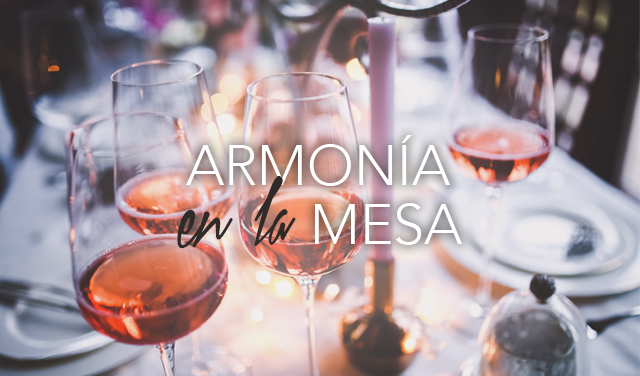Harmony at the Table

Like all works of art, wine deserves our respect. Dreams, effort and enthusiasm went into making it a unique product, which should be respected as a historical event. Like a photograph, it captures a moment in time, telling us about a particular area, a particular climate and a particular way of doing things. Wine is a piece of the past that we drink in the present, in the here and now. A sliver of time, alive and constantly evolving.
Eating is essential to our survival, but at the same time, we can transform it into one of the most personal, enriching and exciting experiences possible. This is why I consider gastronomy the most complete art form of all: we can see, smell, touch and listen to it; we can taste it. It awakens our senses, leaving us with a personal and inalienable memory that lasts forever.
A dish is harmonious when the sum of all the ingredients is just right and the explosion of each, individual flavor transforms into an indivisible whole. Adding an "external" element like wine to this harmony – an element that contributes a sense of balance to enhance or contrast – will stir up emotions deep within us. Absolute satisfaction.
Yes, I'm a firm believer in the art of pairing. When we talk about pairing, we mean combining a dish with a drink – in this case, wine – according to our traditions and in keeping with our customs. After all, we always end up choosing the wine we like, seeking out the memory of a previous occasion that left its mark. However, to ensure the success of our selection, it is important to keep in mind not only with what we will be accompanying the wine, but also with whom we will be sharing it...
We combine food and drink on a daily basis, as part of our tradition or simply because we enjoy it. By way of example, imagine we order a brioche for breakfast one day. Guided by our criteria, we would automatically order coffee or coffee with milk or chocolate milk... External factors might modify this everyday harmony. The dish is as important as the "where" and the "when." Suppose we are enjoying our brioche at a bakery on a winter's day. We would be far more likely to order coffee with milk, whereas in the summer, we might opt for a cold glass of chocolate milk instead. Both pairings are equally valid; we simply adapt our sensations to the setting and context to enjoy a greater sense of well-being.
Whenever I try a wine or a dish, I think about possible combinations. It is inevitable, instinctive. The different options inspire me to reflect and always take my thinking further, because you have to pay close attention to all of the details to ensure a satisfactory result. A pairing should be fun, it should awaken curiosity and hold our interest at all times, it should inspire conversation between the diners. Pairing food and wine is a relationship that requires prior study. By paying close attention to everything we try, we expand our record of flavors and, consequently, the array of possible combinations.
The crux of the matter is to develop an awareness of the wine we drink. The acidity, sweetness, body, tears, aroma, bouquet, etc. will seduce us, but it is the whole – the sum of the parts – that will make us fall in love.
Imagine a wine as a collection of different notes that create a series of chords that, as they gradually unfold across the palate, end up merging into a single melody.
Joan Lluís Gómez by Joan Lluís Gómez
My career has been driven by restlessness and curiosity. My interest in the world of beverages was awoken when taking a course in bartending with Jose Maria Gotarda, this was really when I first conscientiously tried preparing different drinks so I could then prepare and understand cocktails.
My time at Restaurant Casa Nostra in Corbera de Llobregat together with the Balbina, helped me understand the importance of wine or drinks with dishes. I was doing all this whilst studying self-taught until I took the CETT sommeliers course, this motivated me to continue training for the International Higher Certificate in Wines and Spirits at WSET.
Over time I myself was the one teaching courses, such as those aimed at Forcem hospitality professionals, as well as collaborating with magazines and holding the occasional tasting for people interested in the world of wine and food, all combined with work at Sant Pau (Carme Roscalleda’s Restaurant).
Being active helps to study, so you can learn and share.
Tasting Notes
We want to know more, so we submit Joan Lluís to our particular questionnaire:
1."Tweet" the answer: what’s a great wine?
An honest and complex wine that conveys its origin and gives us the information on the harvest.
2.Some believe that the wine world is a closed circle only suitable for experts. Your reason to convince them otherwise?
If only the experts could enjoy the different disciplines of the arts, it would be a world full of ignorance. We have to be open minded to everything unknown in order to enrich ourselves.
3.Banish a myth about wine
The wine: the older the better.
4.Why would you wait 20 years to open a bottle?
I would buy a bottle with 20 years of history, but I wouldn’t wait to open it.
5.Choose a personality and a wine - (Torres) - with whom you would share a glass and a conversation?
I would share a conversation with Jaume Mateu (aka Tortell Poltrona, a famous clown), whilst enjoying a glass of Mas La Plana.
6.What is fashionable in the world of wine and what will always be?
Fresh and aromatic wines.
7. Finally, complete the following statement: No justice has been done with________
Long-aged white wines.
